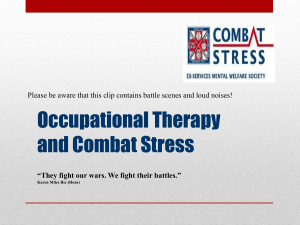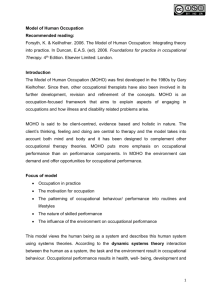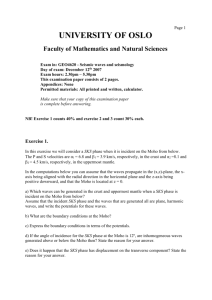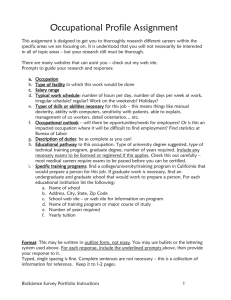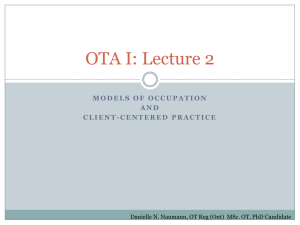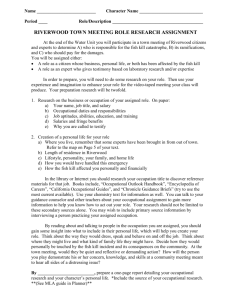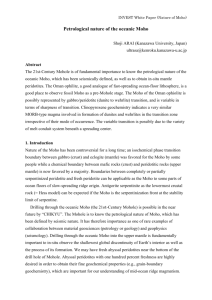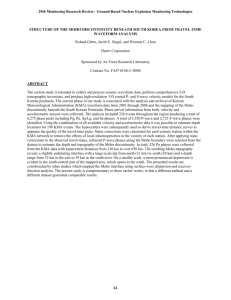MOHO Model Definition: Occupational Therapy Discussion
advertisement
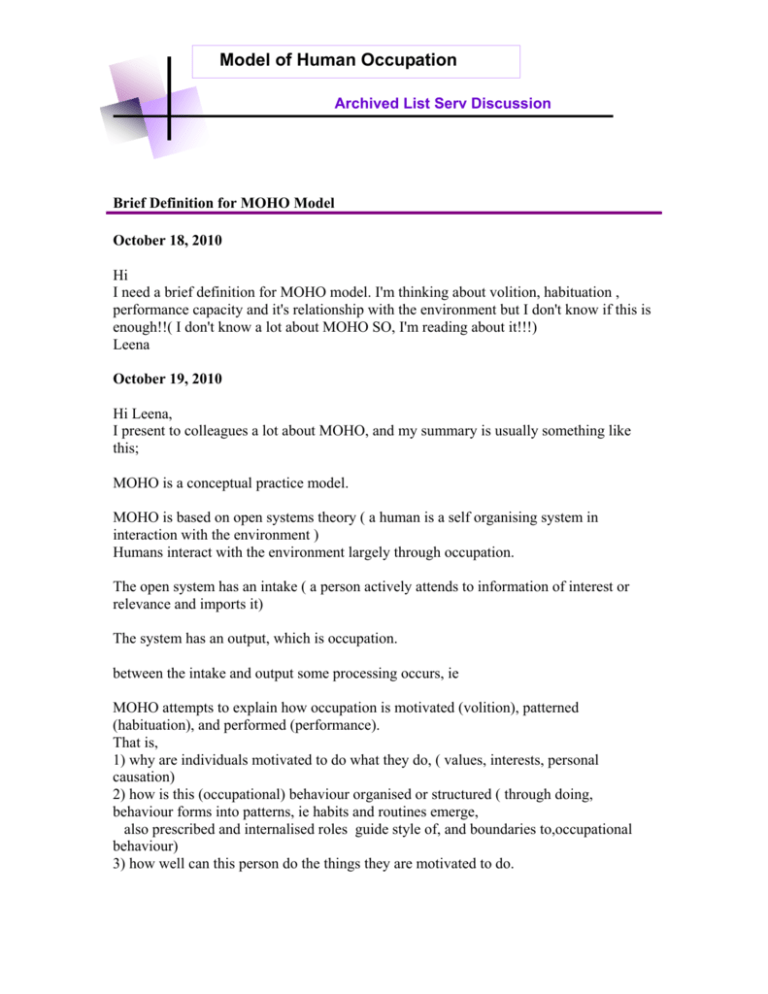
Model of Human Occupation Archived List Serv Discussion Brief Definition for MOHO Model October 18, 2010 Hi I need a brief definition for MOHO model. I'm thinking about volition, habituation , performance capacity and it's relationship with the environment but I don't know if this is enough!!( I don't know a lot about MOHO SO, I'm reading about it!!!) Leena October 19, 2010 Hi Leena, I present to colleagues a lot about MOHO, and my summary is usually something like this; MOHO is a conceptual practice model. MOHO is based on open systems theory ( a human is a self organising system in interaction with the environment ) Humans interact with the environment largely through occupation. The open system has an intake ( a person actively attends to information of interest or relevance and imports it) The system has an output, which is occupation. between the intake and output some processing occurs, ie MOHO attempts to explain how occupation is motivated (volition), patterned (habituation), and performed (performance). That is, 1) why are individuals motivated to do what they do, ( values, interests, personal causation) 2) how is this (occupational) behaviour organised or structured ( through doing, behaviour forms into patterns, ie habits and routines emerge, also prescribed and internalised roles guide style of, and boundaries to,occupational behaviour) 3) how well can this person do the things they are motivated to do. Additionally through acting in the world, we receive feedback from what we do, and have thoughts and feelings about it, which is taken back into the system (intake), creating change over time. The key to understanding the model is to understand that all the components described above are in a constant dynamic interaction with each other. "Resonating", as Garry Kielhofner said. And when any part of it changes ( process skill, environment, values, roles etc ) the whole dynamic will shift. sometimes this is not in a healthy direction, which is occupational dysfunction, or a state of disorder within the system. Any definition should include i think, open system, self organisation, motivation, pattern, performance, environment, change over time through doing, dynamic interaction, self-organising, and lastly occupation. Difficult to do in a few words. My patients articulate it better than anyone, and they don't even know the theory! Hope this helps. regards Tim james October 19, 2010 Hi Leena The definition I use (and probably stole!) is: "a way of understanding how human occupation is motivated (VOLITION), organised (HABITUATION), performed (PERFORMANCE) and influenced by the environment" regards David October 19, 2010 Dear Leena, Thanks for your e-mail……please find below a short and then a longer overview of MOHO, Short definition: MOHO explains how meaningful daily activities (occupations) are motivated, organized into everyday life patterns, and performed in the context of the environment. Long definition: MOHO provides a framework (or model) for occupational therapist to understand how to use daily activities therapeutically to support people’s health. It seeks to explain how meaningful daily activities are motivated, patterned, and performed. First motivation….MOHO supports an understanding of how people are motivated and make choices for doing the activities that fill their lives. To explain human motives for daily activities, MOHO answers critical questions e.g., what accounts for the individual differences in what people want and choose to do?, why is one bored by an activity that another enjoys?, why does one person find valuable what another considers a waste of time? Secondly, MOHO supports an understanding of why everyday life is made up of recurrent patterns of behaviour in familiar physical and social environments. People behave in similar ways over and over again, they follow similar patterns of time use, and they do things in pretty much the same way they did them before. A great deal of human life simply follows a routine pattern of daily activities. These routine patterns support the fulfilment of role responsibilities….being mothers, friends, workers, sons….…giving us a sense of who we are. Finally, MOHO supports an understanding of how people perform daily activities. Whether it is lifting food to one's mouth or playing first violin in an orchestra, humans demonstrate fine and coordinated movements when they do things. When performing daily activities, people also anticipate, plan, observe what happens, make adjustments and decide what to do next. Whether it is getting one's clothes washed, folded, and stored away in the closet or designing & assembling a car, people show an uncanny ability to figure out how to get something done. People also participate and communicate with others. From simple conversation to participation in a scientific discussion - the ability to coordinate action and share information is part of engaging in everyday activity. MOHO, therefore, explains how daily activity is motivated, organized into everyday life patterns, and performed in the context of the environment. MOHO also provides support for occupational therapist to use this theory in practice. There are assessments (which support therapists to ask questions to understand people’s lack of engagement in daily activity) & intervention protocols (which support therapist, use daily activities therapeutically to impact health). Hope this is helpful, Warm wishes, Prof Forsyth October 19, 2010 Leena, this is what I use. "The Model of Human Occupation is the oldest conceptual practice model of Occupational Therapy which is based on occupation and centered on the client. It explains how occupational participation emerges, occurs and changes at any given time and context and through the life span, integrating the motivational and the organizational aspects of performance and routines, the mind body capacities and the environmental impact in a dynamic and constant interaction which leads on a unique participation in occupations, occupational identity and occupational competence. MOHO provides a theoretical framework, a therapeutic reasoning process, an evaluation process with correspondant assessments, and an intervention process with correspondant protocols for intervention, strategies and program development guidelines. It also provides a strong body of literature supporting evidence based practice. Because is a solid internationaly researched client centered and occupational based model it can be applied with a wide variety of populations of different cultures and social realities, ages, and needs, including people with and without disabilities." I call it the "people´s model". Warm big hug for you Leena and for all Carmen Gloria de las Heras, MS, OTR Chile October 19, 2010 HI Leena, I am a professor at A.T. Still University and my students are going to attempt to answer your question: MOHO takes a holistic approach working from top down beginning with the actual occupation. MOHO considers human beings to be an open system consisting of volitional, habituation, and performance capacity and considers how these three aspects interact with each other and the environment. You may want to explore systems theory because MOHO is based on it ( Bertalanffly). The O.T. practice framework is strongly influenced by MOHO. Volition is primarily concerned with motivation. Habituation refers to habits and roles. Performance capacity is the ability to do things depending on physical and mental components. We hope this helps! Sincerely, Mary October 19, 2010 Hi Lena, Here's a real quickie definition: "MOHO is a concept that explains how a person uses their will, drill and skill to interact with the environment." (Will, drill and skill being Volition, Habituation and Performance Capacity) Hope it helps! John October 19, 2010 Dear Tim, Lovely to hear from someone in New Zealand…..my twin brother lives in NZ now! I liked your focus on systems thinking to help us explain how meaningful daily activities (occupations) are motivated, organized into everyday life patterns, and performed in the context of the environment. Update below with an example….. Dynamical systems** MOHO was originally based on concepts of open systems and general systems theory. As these ideas were expanded and revised in more recent dynamical systems theory, the use of systems concepts in MOHO has evolved also. What does a dynamical system look like in our practice? Let’s look at a part of Bob’s occupational life….. A highly organized process unfolds as people go about their everyday occupations. Consider, for example, Bob doing his morning routine of getting washed, groomed, and dressed. After getting out of bed, he puts on some coffee, takes a shower and shaves and then puts on his work clothes. During much of this time Bob is thinking about an upcoming fishing trip that he is taking on the weekend with his best friend, Fred. During his drive to his job where he is the boss of a plumbing team, he plans how the team will finish up the job they have been working on. As he pulls into his workplace, he calls Fred to remind him to buy some bait and tackle at the fishing supplies shop. It is a dynamical system! Bob is within a dynamical system which explains how he engages in his occupations …….Bob’s habits (habituation) guide his morning routine and frees him to engage in motivational (volitional) anticipation of the upcoming fishing trip. Similarly, while his habit (habituation) of driving to work unfolds, his awareness of the responsibilities (habituation) of his worker role stimulates him to plan the activities of the team. During all this time, Bob’ s physical and mental capacities (performance capacities) are being called upon as he engages in tying his shoes, watching the traffic as he drives, and planning an errand for Fred after work. As this small slice of Bob’s occupational life illustrates, occupation always involves an ongoing dynamic interplay of volition, habituation, performance capacity and the environmental context. Every instance of human occupation reflects a unique configuration of elements that together determine what a person’s chooses to do, how that person performs and what is the outcome of the performance. Dynamical systems are pretty fabby!! and helps us, in very practical ways, support our clinical reasoning…… Warm wishes, Prof Forsyth October 19, 2010 Hi John: I would like to clarify taht Moho identifies clearly the process of occupational change and development through life in progress getting into occupational identity and competence and therefore occupational adaptation. The roots of Activities Therapy from Mosey earlier in time, were not really centered on the client in terms of its application. She included activities and characteristic of group activities but intervention was determined by the OT. Apart from that Anne Mosey presented a book in the eary seventies called THree frames of Reference for Occupational Therapy. Where she included Behaviorism (Operant Conditioning), Object Relations (psychoanalitical approach) and the recapitulation of ontogenesis (also a psychology approach to explain development of people with focus in internal pschological aspects). These three frames of references were not based on occupation, "were cut and paste" from psychology into taht book for OT. They werent at all centered in the client. With my best intentions Carmen Gloria de las Heras, MS, OTR Chile October 19, 2010 Thank you John...I am so happy we can intercahnge experiences of knowledge and practice of our profession. Thank you for understanding my good will on making those observations..Yes, Anne utilized those theoretical bases in the time of the crisis of our Paradigm of Occupation, she had a reason to get the profession recognized by other disciplines..She is one of the OTs who has worked for defining the configuration of knowledge of the profession. I consider her and Gary to be the two most important advocates for defining our configuration of knowledge of OT. And yes, client centrerdness is more complex and has to be reflected in many actions of therapists in practice. Many times, us , clinicians "get to do more than frames of references offers us to do", and that is what I always reafirm, as Gary always said, "knowledge is made with clinicians, theorists, researchers, and most o all with clients". And that is what I see in your experience, you really went into applying a framework but you put into that all your convictions that went beyond that explicit knowledge. All my appreciation and love Carmen Gloria de las Heras, MS, OTR Chile October 22, 2010 Thank you all for your definitions :) I appreciate your help all thank you again leena
